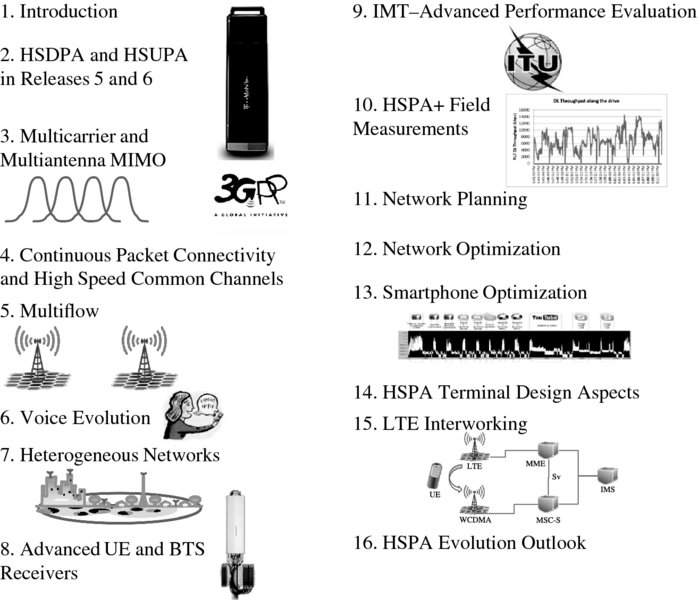Preface
HSPA turned out to be a revolutionary technology, through making high-speed wide-area data connections possible. HSPA is by far the most global mobile broadband technology and is deployed by over 500 operators. Data volumes today are substantially higher than voice volumes and mobile networks have turned from being voice dominated to data dominated. The fast increase in data traffic and customer expectation for higher data rates require further evolution of HSPA technology. This book explains HSPA evolution, also called HSPA+. The book is structured as follows. Chapter 1 presents an introduction. Chapter 2 describes the basic HSDPA and HSUPA solution. Chapter 3 presents multicarrier and multiantenna evolution for higher efficiency and higher data rates. Chapter 4 explains continuous packet connectivity and high speed common channels. Multiflow functionality is described in Chapter 5, voice evolution in Chapter 6, and heterogeneous networks in Chapter 7. Advanced receiver algorithms are discussed in Chapter 8. ITU performance requirements for IMT-Advanced and HSPA+ simulation results are compared in Chapter 9. Chapters 10 to 13 present the practical network deployment and optimization: HSPA+ field measurements in Chapter 10, network planning in Chapter 11, network optimization in Chapter 12, and smartphone optimization in Chapter 13. Terminal design aspects are presented in Chapter 14. The inter-working between LTE and HSPA is discussed in Chapter 15 and finally the outlook for further HSPA evolution in Chapter 16. The content of the book is summarized here in Figure P.1.

Figure P.1 Contents of the book.
Acknowledgments
The editors would like to acknowledge the hard work of the contributors from Nokia, from T-Mobile USA, from Videotron Canada, from Teliasonera, from Renesas Mobile and from Signals Research Group: Mika Aalto, Luigi Dicapua, Ryszard Dokuczal, Mikael Guenais, Timo Halonen, Matthias Hesse, Thomas Höhne, Maciej Januszewski, Jean-Marc Lemenager, Thierry Meslet, Laurent Noel, Brian Olsen, Hisashi Onozawa, Hannu Raassina, Karri Ranta-aho, Jussi Reunanen, Fernando Sanchez Moya, Alexander Sayenko, Jeff Smith, Mike Thelander, Jeroen Wigard, Victor Wilkerson, and Carl Williams.
We also would like to thank the following colleagues for their valuable comments: Erkka Ala-Tauriala, Amar Algungdi, Amaanat Ali, Vincent Belaiche, Grant Castle, Costel Dragomir, Karol Drazynski, Magdalena Duniewicz, Mika Forssell, Amitava Ghosh, Jukka Hongisto, Jie Hui, Shane Jordan, Mika Laasonen, M. Franck Laigle, Brandon Le, Henrik Liljeström, Mark McDiarmid, Peter Merz, Randy Meyerson, Harinder Nehra, Jouni Parviainen, Krystian Pawlak, Marco Principato, Declan Quinn, Claudio Rosa, Marcin Rybakowski, David A. Sánchez-Hernández, Shubhankar Saha, Yannick Sauvat, Mikko Simanainen, Dario Tonesi, Mika Vuori, Dan Wellington, Changbo Wen, and Taylor Wolfe.
The editors appreciate the fast and smooth editing process provided by Wiley and especially by Sandra Grayson, Liz Wingett, and Mark Hammond.
We are grateful to our families, as well as the families of all the authors, for their patience during the late night writing and weekend editing sessions.
The editors and authors welcome any comments and suggestions for improvements or changes that could be implemented in forthcoming editions of this book. The feedback is welcome to the editors' email addresses [email protected], [email protected], and [email protected].
